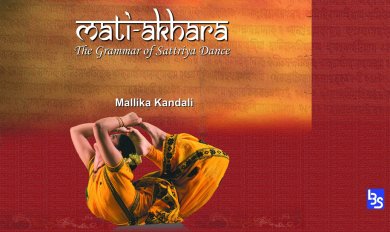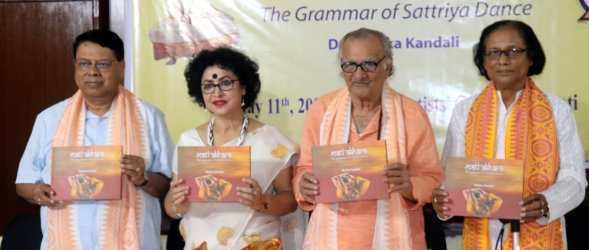
|   |

|   |
Mati-Akhara: The Grammar of Sattriya Dance Welcome addition to Sattriya knowhow by Mallika Kandali - Leela Venkataraman e-mail: leelakaverivenkat@gmail.com June 15, 2023  The latest entry into what India lists in the genre of 'classical dance' (even as heterodox dance scholarship seems to scoff at the very notion of the classical label), Sattriya dance has added to its list of published works, with a succinct work titled Mati Akhara - The grammar of Sattriya Dance. Authored by performer/scholar Dr. Mallika Kandali who, with a PhD degree in dance, is an Associate Professor of R.G. Baruah College, this title, in a succinct manner brings out the entire alphabet of movement cum exercises, in the Mati Akhara (mati meaning ground and akhara meaning exercise). Founded by the Neo Vaishnavite, Srimanta Sankaradeva (1449-1568) - a renaissance person if ever there was one - his deep scholarship combining sainthood, with genius as music composer, playwright and social reformer rolled into one, the dance too reflects many aspects. While totally devotional, Krishna being its one God formula, Sattriya also began as a strong resistance movement against Ahom society. Regarded as both worship and performance, its reformist zeal, while evolving within the monastic ambiance of the Sattras, reflected an anti-caste, secular and worldly approach. This mixed character is reflected in the Mati-Akhara regimen, encompassing in the very earth-bound character of its exercises, spiritual quietude on the one hand and intense physicality on the other. What in Sankaradeva's time emerged as the alphabet of movement for dance, has evolved in sophistication through the work of his successors.  Book release A list of all the Assamese terminology with correct pronunciations, neat black and white photographs for illustrating all the Mati Akhara exercise patterns and movements by male and female dancers according to the Stree and Purusha bhangir, makes for very clear understanding. Foot positions are very clearly shown. Being a scholar, the corresponding technical term for each body position and movement, from the Sanskrit terminology in the Natya Sastra or Abhinaya Darpana or Sangit Ratnakar makes the reading more familiar for the general reader. Utha (standing), baha (squatting), thiya (standing), calana (gait), ulaha (wavy movements), pak (turns and spins), citika (springing) are all clearly mentioned avoiding confusion. Just like hand and foot movements leading to a Karana, a combination of which can lead to Khanda which when added to become a mandala, the Mati Akhara movements provide the basic text for knitting and forming movements for the dance. That Sankaradeva, with his open mindedness, set up a tradition by freely borrowing movements from indigenous Assamese traditions already existing like Devadasi or Nati dance from the Bodo community dance form that prevailed and other folk cultures, sculptural tradition, paintings in the north eastern region, is clearly mentioned. While based on the Mati Akhara genealogy, each Sattra has evolved its own convention of movements. Demanding phenomenal balance, moves like Kachai pani khava (tortoise and turtle drinking water) and Marai pain khowa (peacock drinking water), are examples of Mati Akharas which not many can master. In rare exceptional instances, one sees female dancers (who now do male dances too) executing these movements. Mallika also points out postures and movements which resemble Odisha's Bandho nritya. For any person wanting to be informed on the movement grammar of how Sattriya works, this book makes for easy reading. And Mallika Kandali explains clearly the physical, along with the deeper, less visible and psychological benefits resulting from each of the Mati Akhara exercises. Published by LBS Price: Rs.500  Writing on the dance scene for the last forty years, Leela Venkataraman's incisive comments on performances of all dance forms, participation in dance discussions both in India and abroad, and as a regular contributor to Hindu Friday Review, journals like Sruti and Nartanam, makes her voice respected for its balanced critiquing. She is the author of several books like Indian Classical dance: Tradition in Transition, Classical Dance in India and Indian Classical dance: The Renaissance and Beyond. Post your comment Please provide your name / email id when you use the Anonymous / blog profile to post a comment. All appropriate comments posted in the blog will also be featured in the site. |